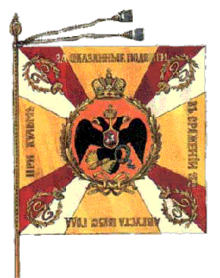Preobrazhensky Life Guards Regiment
Preobrazhensky Regiment ([Преображенский полк] Error: {{Lang-xx}}: text has italic markup (help)) was one of the oldest regiments of the Russian army. It was formed by Peter the Great in the late 17th century from his poteshnye voiska (потешные войска, 'droll forces') during his military games in a village of Preobrazhenskoye (now, a locality in Moscow). The Preobrazhensky regiment has distinguished itself during the Great Northern War of 1700-1721, the Patriotic War of 1812, and the Russo-Turkish War of 1877-1878. The regiment was disbanded by its last commander, Colonel Alexander Kutepov (later a general) in December of 1917.
Timeline
- 1683 - Peter the Great begins to assemble the droll regiments. Initially the number of soldiers were less than fifty.
- 1687 - Droll regiments become regular army regiments Semenovsky regiment and Preobrazhensky.
- 1695 - Preobrazhensky regiment (nine companies) takes part in the Azov campaigns.
- 1696 - The regiment is divided into four battalions and two separate companies of bombardiers and grenadiers.
- 1700—1720 - Takes part in all major battles of the Great Northern War.
- 1700 - Before the Battle of Narva is officially named Leib-Guard Preobrazhensky regiment.
- 1706 - Tzar Peter the Great adopts the military rank of Colonel of Preobrazhensky regiment.
- 1722 - Takes part in the war against Persia.
- 1722 - According to Russian Table of Ranks soldiers of Preobrazhensky regiment were to be considered two ranks higher than in ordinary units.
- 1726 - Moscow company of Preobrazhensky regiment becomes a separate Moscow leib-guard battalion and later Murom leib-guard battalion.
- 1737—1739 - War against Ottoman Empire.
- 1737 - Takes part in the Battle of Ochakov.
- 1742 - War against Sweden.
- 1789—1790 - War against Sweden.
- 1796 - Battalions of the Preobrazhensky regiment are named according to their chiefs: 1st battalion - His Majesty, 2nd battalion - Lieutenant-General Tatischev, 3d Battalion - General-Field-Marshal Suvorov, Grenadier Battalion - Major-General Arakcheev.
- 1805 - As a part of the Grand Duke's Corps of Guards the 1st and 3rd battalions leave St. Petersburg for Austria on 22 August; on 2 December take part in the battle of Austerlitz and return to St. Petersburg on 19 April 1806.
- 1807 - In February the Regiment, consisting of all 4 battalions, starts the march as a part of Grand Duke's Corps of Guards; on 5 June engages Ney’s troops near Gutschadt and Altkirchen and on 14 June takes part in the battle of Friedland; returns to St. Petersburg in August.
- 1808 - On 9 September the 2nd battalion of the regiment enters the Corps of Major-General Strogonov in Vilmanstrand (Finland).
- 1809 - On 10 March, being a part of the Corps of Lieutenant-General Prince Bagration, starts its march to Sweden through the Aland islands; on 14 March fights the enemy's rearguard on the island of Lemland; on 17 March stops on the Eckerö island, closest to the Swedish shore, and after the talks with Sweden begins moving back; returns to St. Petersburg in October.

- 1811 - The regiment is transformed into 3 battalions; each battalion now comprises one grenadier company (grenadier and tirailleur platoons) and three fusilier companies.
- 1812 - As a part of the Grand Duke's Corps of Guards, the regiment moves in March to Vilno, where it joins the 1st Western Army of Barklay-de-Tolly; on 7 September takes part in the battle of Borodino. During the French retreat from Moscow the regiment was in the reserve all the time and returns to Vilno in December.
- 1813 - On 13 January the Guard crosses the Nieman river in the presence of the Emperor; on 2 April participates in the grand parade in the presence of the Emperor and King Frederick William III of Prussia; on 14 April triumphantly enters Dresden; on 2 May takes part in the battle of Lutzen; on the 19th, 20th and 21st of May the regiment is a central reserve under the command of Grand Duke in the battle of Bautzen; on 28 August and 29 August, being a part of 1st Guards Infantry Division under the command of General Yermolov, is distinguished in the battle of Kulm.
- 1814 - On 13 January in the presence of the Emperor Alexander I the Regiment crosses the Rhine at Basel and as a part of the reserve of the Main Army under Barklay-de-Tolly, participates in every offensive and retreat until the battle of Paris (30 March); on 31 March triumphantly enters the capital of France; 1st battalion of the regiment has its bivouac near the Palace of Tuileries. After staying in Paris for more than two months the Regiment leaves for Normandy, embarking at Cherbourg on 15 June and on 12 August entering St. Petersburg through the Triumphal arch, constructed by the Emperor's order in the memory of excellent service of the Guard in 1812—1814.
- 1877—1878 - War against Ottoman Empire.
- 1906 - First Battalion excluded from the regiment and stripped of Leib-Guard privilegies, instead the new first battalion of the regiment is formed from cavaliers of the Order of St. George and heroes of the Russo-Japanese War.
- 1914—1917 - World War I.
- 1917 - Disbanded in December by Alexander Kutepov, its last commander.
Flag

The Regimental flag was of St.George's colours with inscription: "For displayed feats in battle of Kulm 17th of August 1813". (Date given in old style Julian Calendar — 29 August 1813 NS).
This colour was given to the Regiment in order to celebrate its action at Kulm, where the outnumbered Preobrazhensky regiment withstood the charge of French troops.
External links
- History of Preobrazhensky regiment - in Russian
